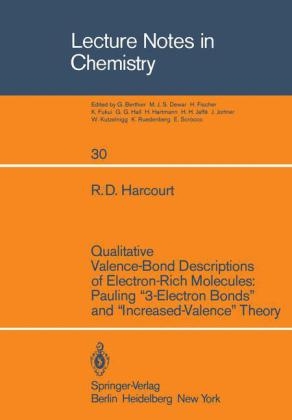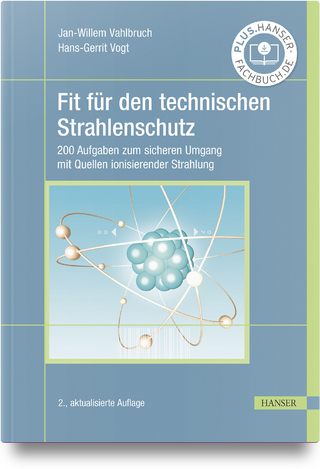
Qualitative Valence-Bond Descriptions of Electron-Rich Molecules: Pauling “3-Electron Bonds” and “Increased-Valence” Theory
Springer Berlin (Verlag)
9783540115557 (ISBN)
- Titel erscheint in neuer Auflage
- Artikel merken
1 Atomic Orbitals, Electron Spin, Linear Combinations.- 1-1 Atomic Orbitals.- 1-2 Electron.- 1-3 Linear Combinations of Wave Functions.- 2 Pauling “3-Electron Bonds”, 4-Electron 3-Centre Bonding and the Need for an “Increased-Valence” Theory.- 2-1 Introduction.- 2-2 Electron Deficient and Electron Excess Bonding Units.- 2-3 Delocalized Molecular Orbital Theory for 4-Electron 3-Centre Bonding Units.- 2-3(a) Symmetrical 4-electron 3-centre bonding: H3?.- 2-3(b) Non-symmetrical 4-electron 3-centre bonding: N2O and F2O2.- 2-4 Standard Valence-Bond Theory for N2O and F2O2.- 2-4(a) The octet rule and the electroneutrality principle.- 2-4(b) Standard valence-bond theory and F2O2.- 2-5 “Long-Bond” Valence-Bond Structures and a Need for an “Increased-Valence” Theory.- 2-5(a) The electroneutrality principle and “long-bond” valence-bond structure.- 2-5(b) The need for “increased-valence” structures.- References.- 3 Wave-Functions and Valence-Bond Structures for 1-Electron Electron Bonds, Electron-Pair Bonds, Pauling “3-Electron Bonds” and “No Bonds”.- 3-1 Diatomic Bonding and Antibonding Molecular Orbitals.- 3-2 One-Electron Bonds.- 3-3 Electron-Pair Bonds.- 3-4 Spin Wave-Functions for One-Electron and Two-Electron Systems.- 3-5 An Important Theorem.- 3-6 The Pauling “3-Electron Bond”.- 3-7 Slater Determinants and the Pauling “3-Electron Bond”.- 3-8 “No Bonds”.- 3-9 Valence-Bond Structures and Bond Properties for H2+, H2, He2+ and He2.- 3-10 Inclusion of Overlap Integrals in Normalization Constants for Molecular Orbitals; Non-Bonded Repulsions.- 3-11 Bond Orders.- References.- 4 Valence-Bond Structures for Some Diatomic Molecules.- 4-1 Molecular Orbital Configurations for Homonuclear Diatomic Molecules.- 4-2 Li2, Be2, N2, F2 and O22?.- 4-3 O2, O+2, O?2 and O2?.- 4-4 CN?, CO and NO+.- 4-5 NO and SN.- 4-6 S2, SO and NO?.- 4-7 ClO and FO.- 4-8 ClF2 and SF3.- 4-9 N-H Bond Strengths of NH3, N2H4 and N2H2, and HN2 ? H + N2.- References.- 5 Pauling “3-Electron Bonds” and Hypoligated Transition Metal Complexes.- 5-1 Hypoligated and Hyperligated Transition Metal Complexes.- 5-2 Pauling “3-Electron Bonds” and the Electronic Structure of [Fe(H2O)6]2+.- 5-3 Metal-Ion Spin-State and Metal-Ligand Bond-Lengths.- 5-4 Interconversion Between Hypoligated and Hyperligated Electronic States.- 5-5 Metal-Ligand ?-Bonding and Pauling “3-Electron Bonds”.- References.- 6 Pauling “3-Electron Bonds”, 5-Electron 3-Centre Bonding and Some Tetra-Atomic Radicals.- 6-1 NO2.- 6-2 CO2? and BF2.- 6-3 Triatomic Radicals with 19 Valence-Shell Electrons: O3?, SO2?, NF2 and C1O2.- 6-4 3-Centre Molecular Orbitals and Pauling “3-Electron Bonds”.- 6-5 Some Tetra-Atomic Radicals.- References.- 7 Some Dimers of Triatomic Radicals with 17 and 19 Valence-Shell Electrons.- 7-1 The Long, Weak N-N Bond of N2O4: Lewis Valence-Bond Theory.- 7-2 The Long Weak N-N Bond of N2O4: Molecular Orbital Theory.- 7-3 The Planetary of N2O4, Covalent-Ionic Resonance and Cis O-O Puling “3-Electron Bonds”.- 7-4 C2O42? and S2O42? Anions.- 7-5 B2Y4 (Y = F, Cl or Br), N2F4 and P2F4.- 7-6 The Geometries of P2F4 and S2O42?.- 7-7 C-Nitroso Dimers and S4N4.- References.- 8 Some Cu(II) Binuclear Transition-Metal Cluster Complexes.- 8-1 Cu(II) Carboxylate Dimers, Cu2 (RCO2)4,Ln.- 8-1(a) Valence-bond structures.- 8-1(b) The antiferromagnetism of Cu(II) carboxylate dimers.- 8-1(c) Covalent-ionic resonance and the antiferromagnetism of Cu(II) carboxylate dimers.- 8-1(d) Covalent-ionic resonance and approximate 6-center molecular orbitals.- 8-2 Cu(II)-X-Cu(II) Linkages.- References.- 9 Excited States.- 9-1 H2: ? ? ?*; C2H4: ? ? ?* Transitions.- 9-2 n ? ?* Transitions.- 9-3 CH3NO and O3: “n + ?*” Transitions.- 9-4 O2: ?x* ? ?y* and ?x ? ?x* Transitions.- Reference.- 10 Pauling “3-Electron Bonds” and “Increased-Valence” Theory for N2O4.- 10-1 Pauling “3-Electron Bonds” for NO2 and “Increased-Valence” Structures for N2O4.- 10-2 “Increased-Valence” Structures and Molecular Orbital Theory for N2O4.- 10-3 “Increased-Valence” Theory and Configuration Interaction for N2O4.- 10-4 Conclusions.- References.- 11 Pauling “3-Electron Bonds” and “Increased-Valence” Structures.- 11-1 Pauling “3-Electron Bonds” and 4-Electron 3-Centre Bonding.- 11-2 Nitrosyl Halides.- 11-3 CH3NO and HNO.- 11-4 Some Dioxygenyl Compounds.- 11-5 Some S-O and S-S Compounds.- 11-6 O3, SO2, S2O, NO2.- 11-7 Pauling “3-Electron Bonds” and 6-Electron 4-Centre Bonding: N2O2, Cl2O2, S2O2 and S2I42+.- 11-8 NO2, NO2?, ClO2, SO2? and SO3.- 11-9 N2O4, N2O3 and FNO2.- 11-10 Sym NO3 and Asym N2O4.- 11-11 Conclusions.- References.- 12 “Increased-Valence” Structures Constructed from Lewis Structures: Delocalization of Lone-Pair Electrons into Vacant Bonding Orbitals.- 13 “Increased-Valence” Structures for N-Centre Bonding Units.- 13-1 N20 and some Isoelectronic Molecules and ions with 4-Electron 3-Centre Bonding Units.- 13-2 N2O4, C2O42? and (RNO)2, with 6-Electron 4-Centre Bonding Units.- 13-3 Some Comments on 6-Electron 4-Centre Bonding Units.- 13-4 Cyclic 6-Electron 4-Centre Bonding Units.- 13-5 Branching 6-Electron 4-Centre Bonding Units.- 13-6 6-Electron 5-Centre Bonding Units.- 13-7 8-Electron 6-Centre Bonding Units.- 13-8 “Increased-Valence” Structures for Longer N-Centre Bonding Units.- 13-8(a) S4N3+: 10-electron 7-centre bonding.- 13-8(b) S4N4: 12-electron 8-centre bonding.- 13-8(c) (SN)X: Polymerized Pauling “3-electron bonds” and polymerized 6-electron 4-centre bonding units.- 13-9 Paramagnetic “increased-Valence” structures.- References.- 14 Delocalization of Lone-Pair Electrons into Anti-Bonding Orbitals: “Increased-Valence” Structures, Molecular Orbital Theory and Atomic Valencies.- 14-1 Delocalization of Lone-Pair Electrons into Antibonding Orbitals.- 14-2 Approximate Molecular Orbital Theory for 4-Electron 3-Centre Bonding Units.- 14-3 Atomic Valencies for “increased-Valence” Structures.- References.- 15 Slater Determinants and Wave-Functions for “Increased-Valence” Structures.- 15-1 “Increased-Valence” Wave-Functions for 4-Electron 3-Centre and 6-Electron 4-Centre Bonding Units.- 15-2 Spin Degeneracy and Wave-Functions for “Increased-Valence” Structures.- 16 Classical Valence Structures and Quinquevalent Nitrogen Atoms.- References.- 17 Some Tetrahedral Molecules and d?–P? Bonding for Some Sulphur Compounds.- 17-1 d-Orbitals as Polarization and Hybridization Functions.- 17-2 F2SO, F2SS and (CH3)2SO.- 17-3 F3NO, (CH3)3NO, F3SN and FSN.- 17-4 Sulphones XYSO2.- 17-5 NO43?, PO43? and F3PO.- 17-6 S2On2? (n = 3, 4, 5, 6).- References.- 18 Transition Metal Complexes With CO, N2, NO and O2 Ligands.- 18-1 Carbonyl Complexes.- 18-2 Dinitrogen Complexes.- 18-2(a) CoH(N2)(PPh3)3.- 18-2(b) [{Ru(NH3)5}2N2] 4+.- 18-3 Transition Metal Nitrosyl Compounds.- 18-4 Dioxygenyl Adducts.- 18-4(a) Oxyhaemoglobin.- 18-4(b) Cobalt Oxygen Carriers.- References.- 19 Some Electron-Excess ?-Bonded Systems.- 19-1 Trihalide Anions and some Related Molecules.- 19-2 The Polyhalide Anions.- 19-3 Xe2F3+ and H2F3-.- 19-4 ClF5 and SF6.- 19-5 Thiothiophthenes.- References.- 20 Intermolecular Donor-Acceptor Complexes.- 20-1 Quantum Mechanical Description of Donor-Acceptor Complexes.- 20-2 Complexing of Trimethylamine with Molecular Iodine.- 20-3 Hydrogen Bonding Between Two H2O Molecules.- 20-4 Reformulation of Charge-Transfer Theory.- 20-5 H5O2+ and HF2?.- 20-6 2:1 Donor-Acceptor Complexes.- References.- 21 Base-Displacement Reactions and Electron Conduction in Alkali Metals.- 21-1 Introduction.- 21-2 Lowry-Brønsted Acid-Base Reactions.- 21-3 Walden Inversion Mechanism.- 21-4 Electron conduction in Alkali Metal Solids.- 21-5 E2 Elimination Reactions.- References.- 22 Free-Radical and Spin-Paired Diradical Reactions.- 22-1 Types of Free Radical Reactions.- 22-2 R + 03 ? RO + O2, with R = H, Cl, and NO.- 22-3 Reactions of O2 with Fe(II) Porphyrin Complexes.- 22-4 “1,3 Dipolar” (or “Zwitterionic Diradical Hybrid”) Cycloaddition Reactions.- 22-5 Thermal Decomposition of o-Nitrophenylazide.- References.- 23 Some Comparisons of Types of Wave-Functions for 4-Electron 3-Centre Bonding Units.- 23-1 Complete Valence-Bond Resonance.- 23-2 Simple Molecular Orbital.- 23-3 Standard Valence-Bond Resonance.- 23-4 Non-Paired Spatial Orbital.- 23-5 Increased-Valence.- 23-6 “Improved” ?(IVBO) and ?(Best).- 23-7 Conclusions.- References.- 24 A Note on Pauling “3-Electron Bonds” and Covalent-Ionic Resonance.- Appendix Atomic Orbital Overlap and Resonance between Standard and “Long-Bond” Lewis Structures.
| Reihe/Serie | Lecture Notes in Chemistry |
|---|---|
| Zusatzinfo | X, 264 p. |
| Verlagsort | Berlin |
| Sprache | englisch |
| Maße | 170 x 244 mm |
| Gewicht | 481 g |
| Themenwelt | Naturwissenschaften ► Chemie ► Physikalische Chemie |
| Schlagworte | Chemical Bond • Cluster • Cobalt • Configuration Interaction • metals • Molecule • Organische Chemie • Planet • Reactions • Structure • Theoretical Chemistry • Theoretische Chemie • Valenzstrukturmethode • Walden inversion • Wave |
| ISBN-13 | 9783540115557 / 9783540115557 |
| Zustand | Neuware |
| Informationen gemäß Produktsicherheitsverordnung (GPSR) | |
| Haben Sie eine Frage zum Produkt? |
aus dem Bereich



